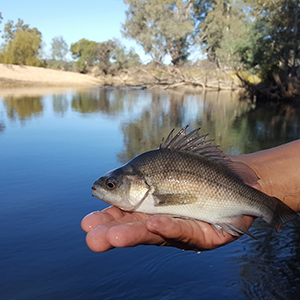Larval fish sensitivity to a simulated cold-water pulse varies between species and age

Accepted: 27 June 2022
Supplementary: 161
HTML: 135
All claims expressed in this article are solely those of the authors and do not necessarily represent those of their affiliated organizations, or those of the publisher, the editors and the reviewers. Any product that may be evaluated in this article or claim that may be made by its manufacturer is not guaranteed or endorsed by the publisher.
Authors
The release of cold-water from hypolimnetic zones of impoundments sharply reduces downstream riverine water temperature. This cold-water pollution (CWP) can extend for hundreds of kilometres, severely challenging the physiological ability of aquatic fauna, particularly ectotherms such as fish, to maintain essential processes such as metabolism, development and growth and survival. The impact of CWP on native fish, especially early life stages, is poorly known. We investigated the effect of a 24-hour exposure to a range of environmentally-related water temperatures (8, 10, 12, 14, 16, 18 and 20°C) on three age-classes (<24-hour-old, 7-day and 14-day-old larvae) of two Australian native fish species: Murray cod (Maccullochella peelii) and Macquarie perch (Macquaria australasica). Overall, larvae of M. peelii were more sensitive to lower water temperatures and hence CWP than M. australasica, indicated by higher rates of equilibrium loss. Larvae of M. peelii were most sensitive to exposure at seven days old whereas M. australasica larvae were most sensitive at <24-h-old. Using our results, we modelled pre- and post-impoundment temperature scenarios and estimated the downstream CWP footprint for both species in an Australian river reach. Larvae of M. peelii were predicted to be absent from the first 26 km of river downstream of the impoundment compared with no impact on the distribution of M. australasica. Managing riverine water temperature below impoundments is fundamental to promoting positive outcomes for endemic fish on not only a local, but global basis. This study emphasises the differential impact of CWP among the critical early life stages and fish species and highlights the urgent need to better manage hypolimnetic water releases to improve downstream river ecosystems.
Edited by
Pietro Volta, CNR-IRSA Verbania, ItalyHow to Cite

This work is licensed under a Creative Commons Attribution-NonCommercial 4.0 International License.
Similar Articles
- Michela ROGORA, Acidification and recovery at mountain lakes in Central Alps assessed by the MAGIC model , Journal of Limnology: Vol. 63 No. 1 (2004)
- Diego Fontaneto, Roberto Bertoni, The Journal of Limnology's 80th anniversary , Journal of Limnology: Vol. 80 No. 3 (2021): Celebratory Issue - 80th Anniversary of the Journal of Limnology
- Georg A. JANAUER, Is what has been measured of any direct relevance to the success of the macrophyte in its particular environment? , Journal of Limnology: Vol. 60 No. s1 (2001): Scientific and legal aspects of biological monitoring in freshwater
- Beibei Shen, Jinglu Wu, Zhonghua Zhao, A ~150-year record of human impact in the Lake Wuliangsu (China) watershed: evidence from polycyclic aromatic hydrocarbon and organochlorine pesticide distributions in sediments , Journal of Limnology: Vol. 76 No. 1 (2017)
- Paolo Villa, Monica Pinardi, Viktor R. Tóth, Peter D. Hunter, Rossano Bolpagni, Mariano Bresciani, Remote sensing of macrophyte morphological traits: Implications for the management of shallow lakes , Journal of Limnology: Vol. 76 No. s1 (2017): Aquatic biomonitoring: Lessons from the past, challenges for the future
- Jan SYCHRA, Zdeněk ADÁMEK, The impact of sediment removal on the aquatic macroinvertebrate assemblage in a fishpond littoral zone , Journal of Limnology: Vol. 70 No. 1 (2011)
- Colin J. WHITFIELD, Julian AHERNE, Jack B. COSBY, Shaun A. WATMOUGH, Modelling boreal lake catchment response to anthropogenic acid deposition , Journal of Limnology: Vol. 69 No. s1 (2010): Impacts of sulphur and nitrogen deposition in western Canada
- Ana Maria GERALDES, Maria-José BOAVIDA, Do distinct water chemistry, reservoir age and disturbance make any difference on phosphatase activity? , Journal of Limnology: Vol. 62 No. 2 (2003)
- Michela ROGORA, Letizia GARIBALDI, Giuseppe MORABITO, Silvia ARISCI, Rosario MOSELLO, Present trophic level of Lake Alserio (Northern Italy) and prospect for its recovery , Journal of Limnology: Vol. 61 No. 1 (2002)
- Yosef Z. YACOBI, Ilia OSTROVSKY, Helen M. TALBOT, Occurrence of high concentrations of a unique degradation product of chlorophyll-a in particles residing below the thermocline throughout a period of oxygen depletion in Lake Kinneret , Journal of Limnology: Vol. 60 No. 2 (2001)
<< < 58 59 60 61 62 63 64 65 66 67 > >>
You may also start an advanced similarity search for this article.
-
John D. Koehn, Charles R. Todd, Henry Wootton, Michael JoyMarine and Freshwater Research : 2023

 https://doi.org/10.4081/jlimnol.2022.2056
https://doi.org/10.4081/jlimnol.2022.2056





